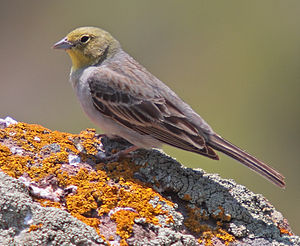Chamber of the Turks
| Chamber of the Turks | ||||||||||||
|---|---|---|---|---|---|---|---|---|---|---|---|---|

Turkish Chamber ( Emberiza cineracea ) |
||||||||||||
| Systematics | ||||||||||||
|
||||||||||||
| Scientific name | ||||||||||||
| Emberiza cineracea | ||||||||||||
| Brehm , 1855 |
The Turkish Chamber ( Emberiza cineracea ) is a bird from the family of the bunting (Emberizidae). A distinction is made between two subspecies within the species .
description
The male can be easily distinguished from other species by its greenish-yellow head and yellowish to yellow throat. The rump is gray, the wings are brownish. The underside is unstriped. In the females only the throat is yellowish, the underside is slightly striped. The females of the Türkenammer can therefore be confused with the females of the Kappenammer . The young birds have a striped underside. The underside of the Türkenammer is gray or yellowish, depending on the subspecies. The Turkish Chamber is 16.5 cm long.
distribution
The western Türkenammer subspecies also occurs in Europe, but only as a summer visitor on a few islands in the Aegean . Small populations breed on Lesbos and Chios , Skyros , Samos , Ikaria and maybe also Corfu . A population of 50 to 100 pairs exists on these islands. Further populations of the western subspecies breed in western Turkey . However, the majority of the Turkish Chambers breed in southeastern Turkey and southern Iran . The Chamber of Turkey winters in southern Turkey and around the Red Sea . The preferred habitat of the Turkish Chamber are stony, little overgrown slopes.
Way of life
Like most bunting, the Turk's Chamber feeds primarily on seeds. Insects are used to feed the young. The call of this type of ammern is a short "kip". The singing sounds like a rough "zru-zru-zru-zru".
The female lays 3–6 whitish gray-blue to black-brown, about 21 mm long eggs.
Others
The Türkenammer was first discovered by Hugh Edwin Strickland and described by Christian Ludwig Brehm in 1855.
swell
- Christopher Perrins: Parey's Nature Guide Plus. Birds. Biology + determination + ecology . Paul Parey Verlag, Berlin 1987, ISBN 3-490-22618-6 .
Web links
- Cinereous Bunting - BirdLife Species Factsheet (en).
- Emberiza cineracea in the endangered Red List species the IUCN 2008. Posted by: BirdLife International, 2008. Accessed January 31 of 2009.
- Videos, photos and sound recordings for Emberiza cineracea in the Internet Bird Collection